Biological Waste (Biohazardous/RMW): Biohazardous waste that is infectious and termed Regulated Medical Waste or "RMW" is that which requires biological inactivation, in an approved manner, prior to final disposal and includes:
* Note that biotoxin waste SHOULD NOT be labeled with the Biohazard label as it is hazardous chemical waste; EHS Biosafety and Hazardous Waste personnel collaborate to provide guidance on the inactivation (e.g., autoclaving or chemical) of toxins. See Biotoxins for more detail.
**Waste placed in sharps containers do not require inactivation prior to disposal.
Other Biological Wastes: These are biological wastes that are not known to be pathogenic to humans and are not regulated by the Virginia Department of Environmental Quality (DEQ). These materials may be disposed in the regular waste stream without prior treatment; however, researchers should consider autoclaving or chemical inactivation prior to final disposal based on risk assessment and applicable grant or permit expectations. These materials include:
One of the most effect methods for the decontamination of biohazardous or infectious material is by steam sterilization. When autoclaving, specific requirements must be met in order to ensure proper inactivation and include:
Specific Requirements for Decontamination by Autoclaving are provided in the IBC’s Policy on Autoclaving.
Recommended "Autoclaving Safely" training is provided courtesy of EHS Biosafety and is available online here (log-in).
SOLID biohazardous waste may be disposed of directly into a Contaminated Materials Container (CMC) where it will be removed by EHS or licensed waste contractor.
If your CMC is improperly prepared or too heavy, Housekeepers will not remove it but will notify you by placing the following pink label on the CMC. You MUST take the corrective action noted to facilitate removal of your CMC.
ATTN: Your CMC box was not picked up because:
X Improperly packaged/labeled
X Overweight (30 lb. weight limit)
Questions? Call EHS at 434.982.4911
CMC Pick Up locations
Notice: When using a lockbox to access the door key, return the key to the lockbox and scramble the code when finished to maintain the chain of custody for biological waste.
CMC Drop Off locations
Notice: If > 30 lbs., laboratorians are responsible for drop off, otherwise CMCs will be removed by Building Services Housekeepers.
Other Locations not listed above
Contaminated Material Container (CMC)
Full View
Other Examples:
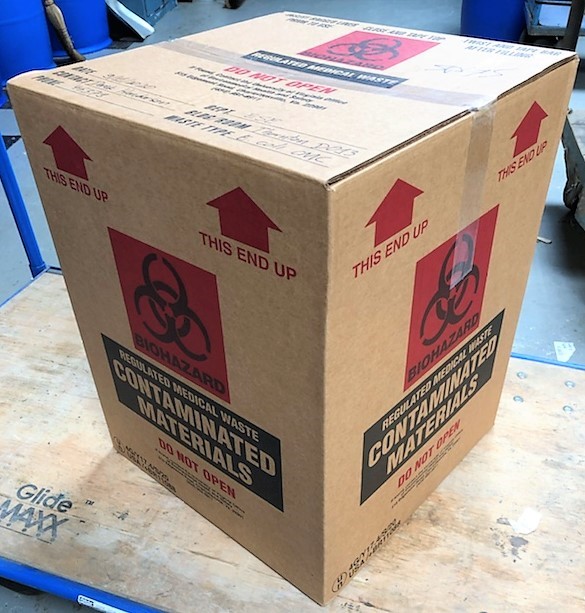
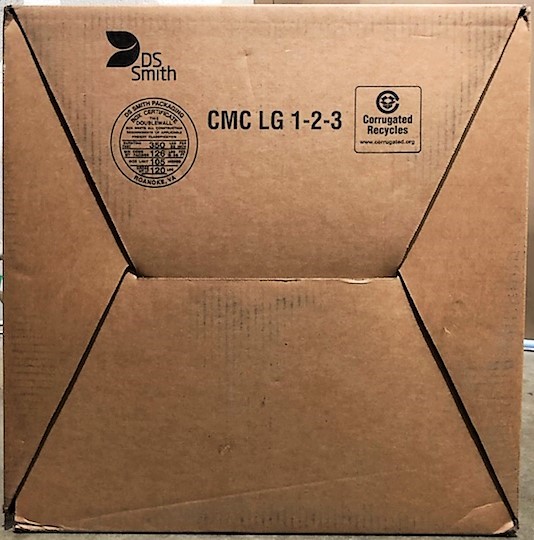
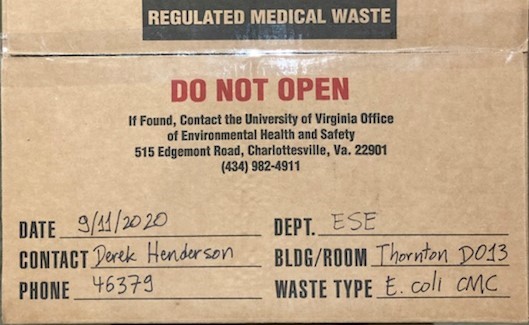
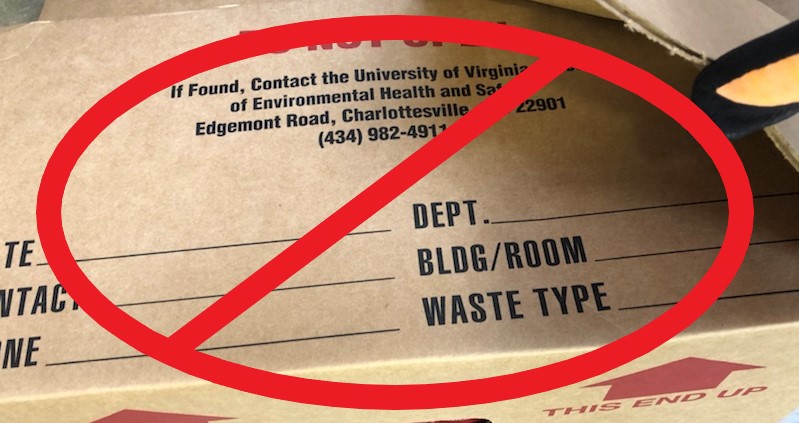
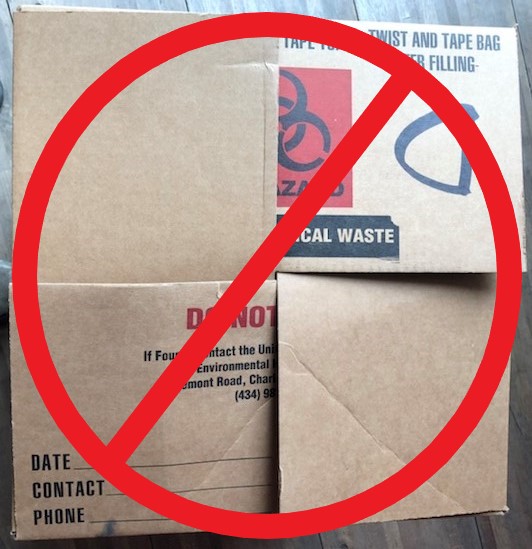

The table below is designed to aid you in determining how to collect, decontaminate, and/or dispose of your waste. BSL-2 indicates biohazardous or regulated RMW waste and BSL-1 indicates "other" biological waste not known to be pathogenic or regulated.
| Type of Waste | Biosafety Level | Collection & Containers | Decontamination Method | Disposal |
|---|---|---|---|---|
| Liquids | BSL-1 |
Use autoclaveable, leak proof plastic (see IBC Autoclaving Policy) Use double containment (pan) May use glass if necessary |
Not required OR Autoclave/Chemically Inactivate |
Sink (down the drain flushed w/ water) |
| BSL-2 |
Use autoclaveable, leak proof plastic (see IBC Autoclaving Policy) Use double containment (pan) labeled with Biohazard label
|
Autoclaving required OR Chemically Inactivate (preferred method) with disinfectant--add bleach to make 10% solution |
Sink (down the drain flushed w/ water) | |
| Solids | BSL-1 |
May be collected in regular waste/trash receptacles Autoclaving recommended using clear bags |
Not required OR Autoclave/Chemical Inactivation |
Place in regular trash |
| BSL-2 | Autoclave in clear bags placed in double containment (pan) with Biohazard label  |
Autoclaving required | Place in regular trash | |
| Place in CMC | No decon; tape and label appropriately | Place in lab for pick up by Housekeeping | ||
| Sharps | BSL-1 or BSL-2 |
Sharps (needles, lancets, suture needles, blades, scalpels) MUST be placed in a sharps container Other sharp-like materials in a form capable of puncturing skin (e.g., broken, contaminated glass) is placed in a sharps container |
No decon; close container when 2/3 full |
Disposed of by EHS OR 434.982.4911 |
| Animal carcasses* | Non-Biohazardous OR Chemical OR Radioactive |
Place in opaque bag |
Return to vivarium freezer (Radioactive must be picked up by EHS) |
Disposed of by EHS |
| BSL-2 |
Place in red bag or opaque bag labeled with the Biohazard label |
Return to vivarium freezer | Disposed of by EHS | |
| Other animal wastes (soiled bedding, cages, etc.) | Non-Biohazardous | Place in opaque/paper bags | Return to vivarium designated drop off location | Disposed of by CCM |
| BSL-2 | Place in clear autoclave bags with Biohazard label  |
Autoclaving required OR Return to vivarium designated ABSL-2 drop off location |
Disposed of by CCM |
* Animal carcasses or wastes that contain hazardous chemicals must be handled as indicated in the ACUC protocol. For general information on carcass disposal see this ACUC policy. Radioactive animal carcasses and associated wastes must be labeled (radioactive warning tape) and collected by EHS Radiation Safety. For more information on radioactive animal carcasses click here.
Human cadavers and recognizable human body parts require special handling. Please contact EHS Biosafety at 434.982.4911 for guidance.
When used in the research lab, these items can be disposed of in the regular waste stream as long as they are void of biohazards and/or hazardous chemicals. Examples of this material include:
For hospital-like waste not used in research (e.g., for patient care), please refer to the Medical Center's "Where Does all that Garbage Go" poster for appropriate disposal.
If they DO NOT contain or ARE NOT contaminated with Radioactive Material (any amount), Chemicals (more than a trace amount) or Biohazardous Material (any amount), then these waste materials are Waste Laboratory Glassware (WLG).
Waste Laboratory Glassware:

For CMC operations and pick up issues, contact Derek Snapp at dcs7e@virginia.edu or 434.982.4911.
Regulatory questions, contact Jennifer Kershner at jmw4qs@virginia.edu or 434.982.4911.